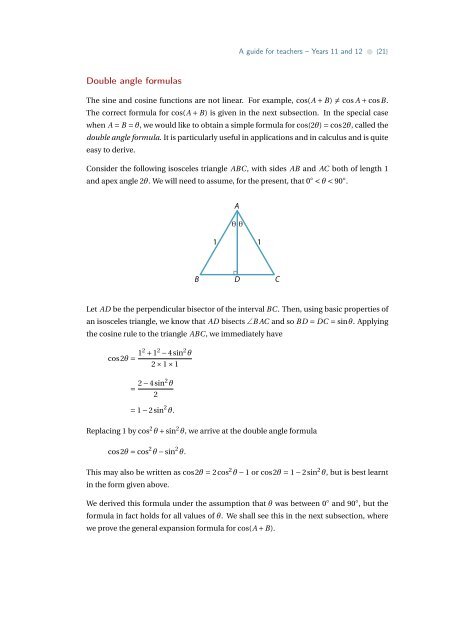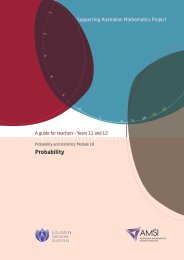Trigonometric functions and circular measure - the Australian ...
Trigonometric functions and circular measure - the Australian ...
Trigonometric functions and circular measure - the Australian ...
- No tags were found...
You also want an ePaper? Increase the reach of your titles
YUMPU automatically turns print PDFs into web optimized ePapers that Google loves.
A guide for teachers – Years 11 <strong>and</strong> 12 • {21}Double angle formulasThe sine <strong>and</strong> cosine <strong>functions</strong> are not linear. For example, cos(A + B) ≠ cos A + cosB.The correct formula for cos(A + B) is given in <strong>the</strong> next subsection. In <strong>the</strong> special casewhen A = B = θ, we would like to obtain a simple formula for cos(2θ) = cos2θ, called <strong>the</strong>double angle formula. It is particularly useful in applications <strong>and</strong> in calculus <strong>and</strong> is quiteeasy to derive.Consider <strong>the</strong> following isosceles triangle ABC , with sides AB <strong>and</strong> AC both of length 1<strong>and</strong> apex angle 2θ. We will need to assume, for <strong>the</strong> present, that 0 ◦ < θ < 90 ◦ .Aθ θ11BDCLet AD be <strong>the</strong> perpendicular bisector of <strong>the</strong> interval BC . Then, using basic properties ofan isosceles triangle, we know that AD bisects ∠B AC <strong>and</strong> so BD = DC = sinθ. Applying<strong>the</strong> cosine rule to <strong>the</strong> triangle ABC , we immediately havecos2θ = 12 + 1 2 − 4sin 2 θ2 × 1 × 1= 2 − 4sin2 θ2= 1 − 2sin 2 θ.Replacing 1 by cos 2 θ + sin 2 θ, we arrive at <strong>the</strong> double angle formulacos2θ = cos 2 θ − sin 2 θ.This may also be written as cos2θ = 2cos 2 θ − 1 or cos2θ = 1 − 2sin 2 θ, but is best learntin <strong>the</strong> form given above.We derived this formula under <strong>the</strong> assumption that θ was between 0 ◦ <strong>and</strong> 90 ◦ , but <strong>the</strong>formula in fact holds for all values of θ. We shall see this in <strong>the</strong> next subsection, wherewe prove <strong>the</strong> general expansion formula for cos(A + B).
















